Aren Jansen
Recomposer: Event-roll-guided generative audio editing
Sep 05, 2025Abstract:Editing complex real-world sound scenes is difficult because individual sound sources overlap in time. Generative models can fill-in missing or corrupted details based on their strong prior understanding of the data domain. We present a system for editing individual sound events within complex scenes able to delete, insert, and enhance individual sound events based on textual edit descriptions (e.g., ``enhance Door'') and a graphical representation of the event timing derived from an ``event roll'' transcription. We present an encoder-decoder transformer working on SoundStream representations, trained on synthetic (input, desired output) audio example pairs formed by adding isolated sound events to dense, real-world backgrounds. Evaluation reveals the importance of each part of the edit descriptions -- action, class, timing. Our work demonstrates ``recomposition'' is an important and practical application.
Long-Form Speech Generation with Spoken Language Models
Dec 24, 2024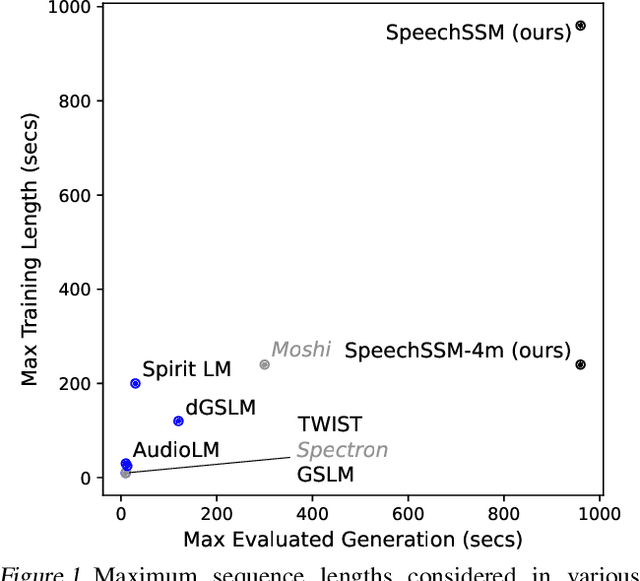
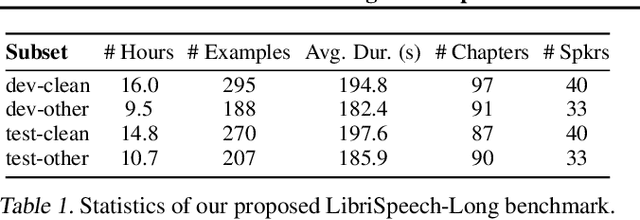
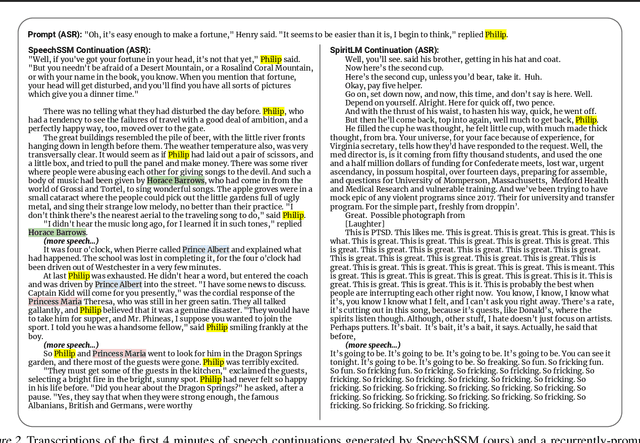
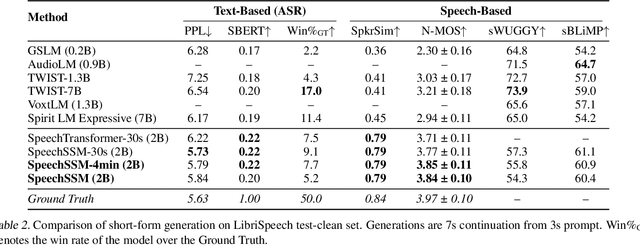
Abstract:We consider the generative modeling of speech over multiple minutes, a requirement for long-form multimedia generation and audio-native voice assistants. However, current spoken language models struggle to generate plausible speech past tens of seconds, from high temporal resolution of speech tokens causing loss of coherence, to architectural issues with long-sequence training or extrapolation, to memory costs at inference time. With these considerations we propose SpeechSSM, the first speech language model to learn from and sample long-form spoken audio (e.g., 16 minutes of read or extemporaneous speech) in a single decoding session without text intermediates, based on recent advances in linear-time sequence modeling. Furthermore, to address growing challenges in spoken language evaluation, especially in this new long-form setting, we propose: new embedding-based and LLM-judged metrics; quality measurements over length and time; and a new benchmark for long-form speech processing and generation, LibriSpeech-Long. Speech samples and the dataset are released at https://google.github.io/tacotron/publications/speechssm/
MELODI: Exploring Memory Compression for Long Contexts
Oct 04, 2024Abstract:We present MELODI, a novel memory architecture designed to efficiently process long documents using short context windows. The key principle behind MELODI is to represent short-term and long-term memory as a hierarchical compression scheme across both network layers and context windows. Specifically, the short-term memory is achieved through recurrent compression of context windows across multiple layers, ensuring smooth transitions between windows. In contrast, the long-term memory performs further compression within a single middle layer and aggregates information across context windows, effectively consolidating crucial information from the entire history. Compared to a strong baseline - the Memorizing Transformer employing dense attention over a large long-term memory (64K key-value pairs) - our method demonstrates superior performance on various long-context datasets while remarkably reducing the memory footprint by a factor of 8.
A Versatile Diffusion Transformer with Mixture of Noise Levels for Audiovisual Generation
May 22, 2024



Abstract:Training diffusion models for audiovisual sequences allows for a range of generation tasks by learning conditional distributions of various input-output combinations of the two modalities. Nevertheless, this strategy often requires training a separate model for each task which is expensive. Here, we propose a novel training approach to effectively learn arbitrary conditional distributions in the audiovisual space.Our key contribution lies in how we parameterize the diffusion timestep in the forward diffusion process. Instead of the standard fixed diffusion timestep, we propose applying variable diffusion timesteps across the temporal dimension and across modalities of the inputs. This formulation offers flexibility to introduce variable noise levels for various portions of the input, hence the term mixture of noise levels. We propose a transformer-based audiovisual latent diffusion model and show that it can be trained in a task-agnostic fashion using our approach to enable a variety of audiovisual generation tasks at inference time. Experiments demonstrate the versatility of our method in tackling cross-modal and multimodal interpolation tasks in the audiovisual space. Notably, our proposed approach surpasses baselines in generating temporally and perceptually consistent samples conditioned on the input. Project page: avdit2024.github.io
Dataset balancing can hurt model performance
Jun 30, 2023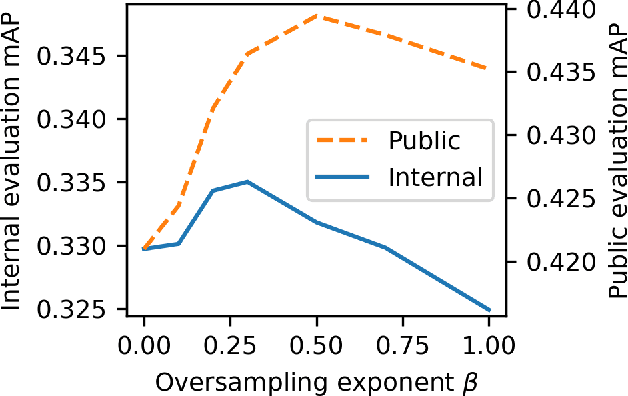

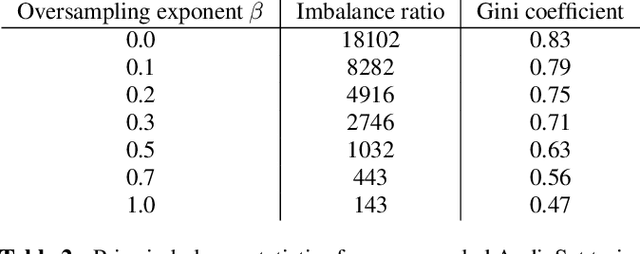
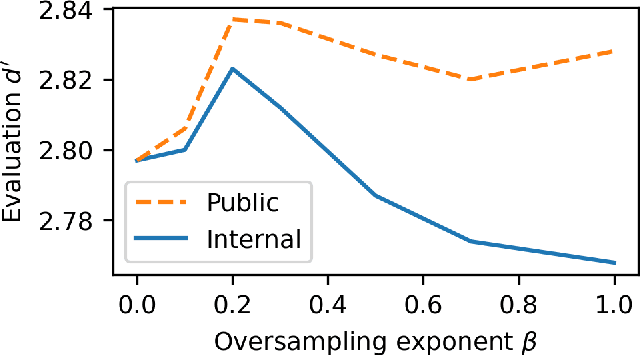
Abstract:Machine learning from training data with a skewed distribution of examples per class can lead to models that favor performance on common classes at the expense of performance on rare ones. AudioSet has a very wide range of priors over its 527 sound event classes. Classification performance on AudioSet is usually evaluated by a simple average over per-class metrics, meaning that performance on rare classes is equal in importance to the performance on common ones. Several recent papers have used dataset balancing techniques to improve performance on AudioSet. We find, however, that while balancing improves performance on the public AudioSet evaluation data it simultaneously hurts performance on an unpublished evaluation set collected under the same conditions. By varying the degree of balancing, we show that its benefits are fragile and depend on the evaluation set. We also do not find evidence indicating that balancing improves rare class performance relative to common classes. We therefore caution against blind application of balancing, as well as against paying too much attention to small improvements on a public evaluation set.
* 5 pages, 3 figures, ICASSP 2023
V2Meow: Meowing to the Visual Beat via Music Generation
May 11, 2023
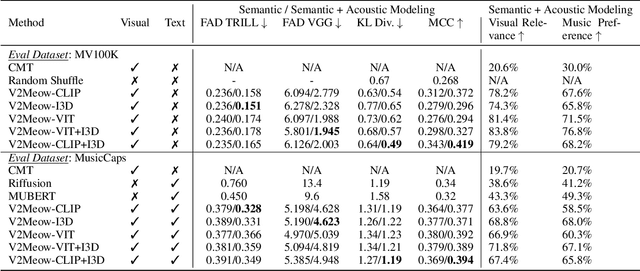

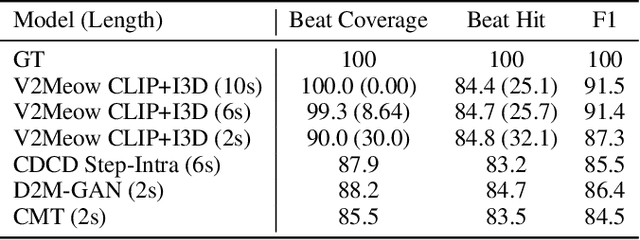
Abstract:Generating high quality music that complements the visual content of a video is a challenging task. Most existing visual conditioned music generation systems generate symbolic music data, such as MIDI files, instead of raw audio waveform. Given the limited availability of symbolic music data, such methods can only generate music for a few instruments or for specific types of visual input. In this paper, we propose a novel approach called V2Meow that can generate high-quality music audio that aligns well with the visual semantics of a diverse range of video input types. Specifically, the proposed music generation system is a multi-stage autoregressive model which is trained with a number of O(100K) music audio clips paired with video frames, which are mined from in-the-wild music videos, and no parallel symbolic music data is involved. V2Meow is able to synthesize high-fidelity music audio waveform solely conditioned on pre-trained visual features extracted from an arbitrary silent video clip, and it also allows high-level control over the music style of generation examples via supporting text prompts in addition to the video frames conditioning. Through both qualitative and quantitative evaluations, we demonstrate that our model outperforms several existing music generation systems in terms of both visual-audio correspondence and audio quality.
MusicLM: Generating Music From Text
Jan 26, 2023



Abstract:We introduce MusicLM, a model generating high-fidelity music from text descriptions such as "a calming violin melody backed by a distorted guitar riff". MusicLM casts the process of conditional music generation as a hierarchical sequence-to-sequence modeling task, and it generates music at 24 kHz that remains consistent over several minutes. Our experiments show that MusicLM outperforms previous systems both in audio quality and adherence to the text description. Moreover, we demonstrate that MusicLM can be conditioned on both text and a melody in that it can transform whistled and hummed melodies according to the style described in a text caption. To support future research, we publicly release MusicCaps, a dataset composed of 5.5k music-text pairs, with rich text descriptions provided by human experts.
MAQA: A Multimodal QA Benchmark for Negation
Jan 09, 2023


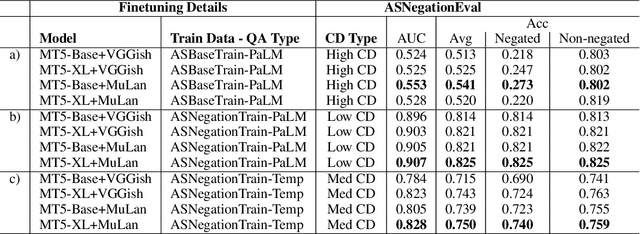
Abstract:Multimodal learning can benefit from the representation power of pretrained Large Language Models (LLMs). However, state-of-the-art transformer based LLMs often ignore negations in natural language and there is no existing benchmark to quantitatively evaluate whether multimodal transformers inherit this weakness. In this study, we present a new multimodal question answering (QA) benchmark adapted from labeled music videos in AudioSet (Gemmeke et al., 2017) with the goal of systematically evaluating if multimodal transformers can perform complex reasoning to recognize new concepts as negation of previously learned concepts. We show that with standard fine-tuning approach multimodal transformers are still incapable of correctly interpreting negation irrespective of model size. However, our experiments demonstrate that augmenting the original training task distributions with negated QA examples allow the model to reliably reason with negation. To do this, we describe a novel data generation procedure that prompts the 540B-parameter PaLM model to automatically generate negated QA examples as compositions of easily accessible video tags. The generated examples contain more natural linguistic patterns and the gains compared to template-based task augmentation approach are significant.
MuLan: A Joint Embedding of Music Audio and Natural Language
Aug 26, 2022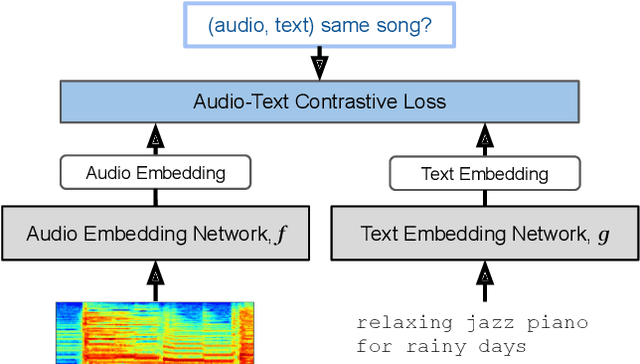


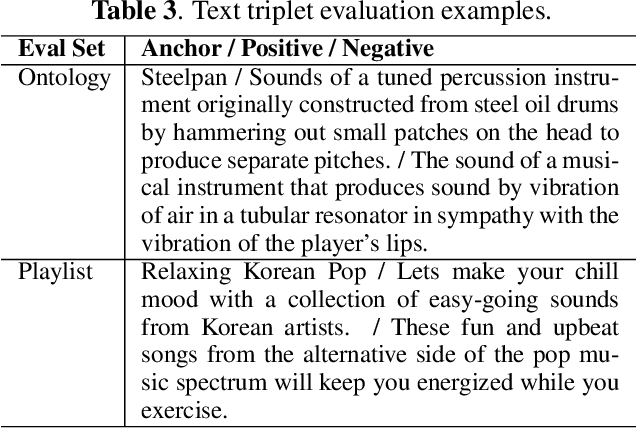
Abstract:Music tagging and content-based retrieval systems have traditionally been constructed using pre-defined ontologies covering a rigid set of music attributes or text queries. This paper presents MuLan: a first attempt at a new generation of acoustic models that link music audio directly to unconstrained natural language music descriptions. MuLan takes the form of a two-tower, joint audio-text embedding model trained using 44 million music recordings (370K hours) and weakly-associated, free-form text annotations. Through its compatibility with a wide range of music genres and text styles (including conventional music tags), the resulting audio-text representation subsumes existing ontologies while graduating to true zero-shot functionalities. We demonstrate the versatility of the MuLan embeddings with a range of experiments including transfer learning, zero-shot music tagging, language understanding in the music domain, and cross-modal retrieval applications.
Text-Driven Separation of Arbitrary Sounds
Apr 12, 2022

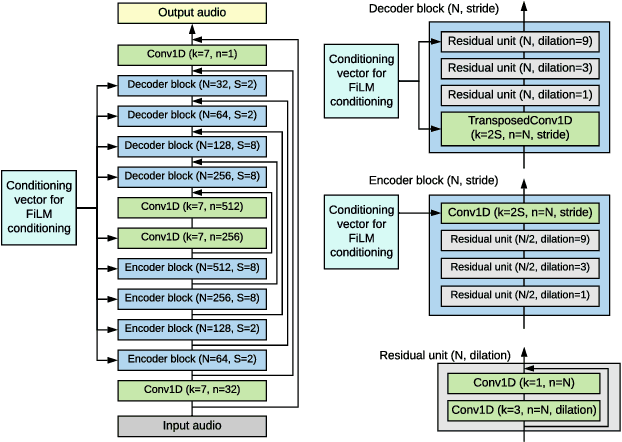

Abstract:We propose a method of separating a desired sound source from a single-channel mixture, based on either a textual description or a short audio sample of the target source. This is achieved by combining two distinct models. The first model, SoundWords, is trained to jointly embed both an audio clip and its textual description to the same embedding in a shared representation. The second model, SoundFilter, takes a mixed source audio clip as an input and separates it based on a conditioning vector from the shared text-audio representation defined by SoundWords, making the model agnostic to the conditioning modality. Evaluating on multiple datasets, we show that our approach can achieve an SI-SDR of 9.1 dB for mixtures of two arbitrary sounds when conditioned on text and 10.1 dB when conditioned on audio. We also show that SoundWords is effective at learning co-embeddings and that our multi-modal training approach improves the performance of SoundFilter.
 Add to Chrome
Add to Chrome Add to Firefox
Add to Firefox Add to Edge
Add to Edge